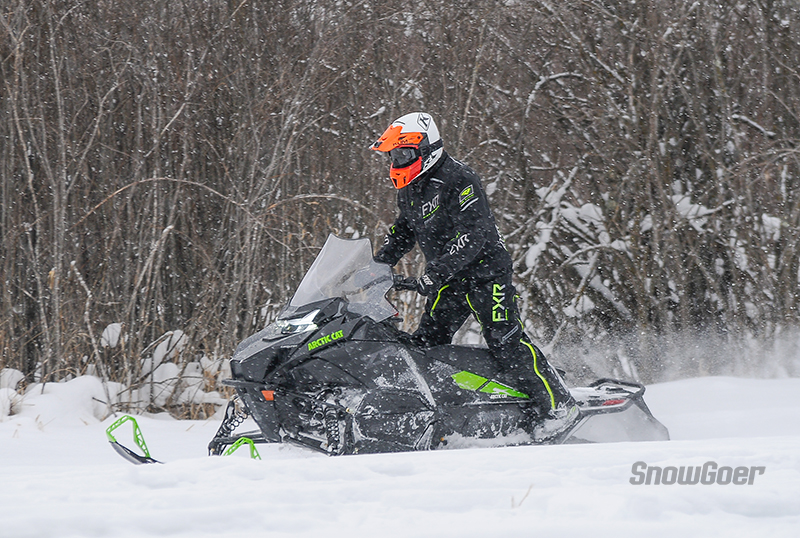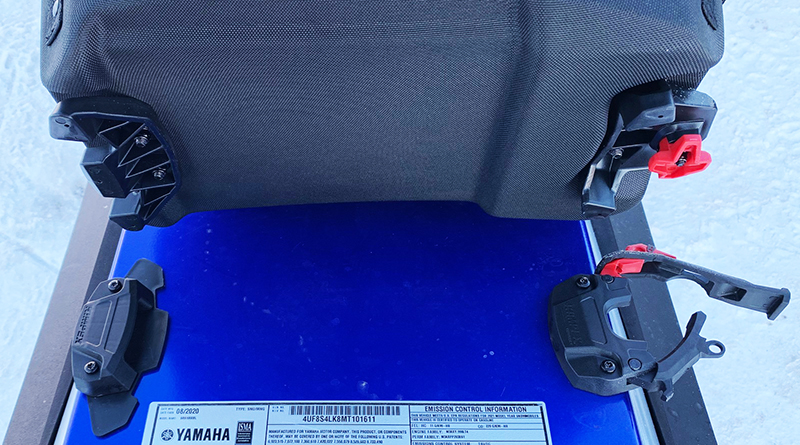
A recent snow season had me proudly wearing some of the best head gear on the planet. The Klim F3 helmet and Oculus goggle are a great tandem to outfit the aggressive rider any day of the week.
While lightweight, the F3 helmet in a blue camo color combination doesn’t sacrifice when it comes to safety. With its dual homologated fiberglass construction, the 3-pound helmet exceeds DOT and ECE standards to protect your noggin in the event of an impact, yet its featherweight design certainly saved on neck-strain throughout a long day of riding.
A customizable fit is accomplished by swapping cheek pads and helmet liners, and the smaller exterior shell combines 13 intake vents with six exhaust vents, resulting in what might be the most feature-laden helmet I’ve ever worn.
Most evident of these highly sought-after features when out for a active day of riding is the massive amount of ventilation. We all hate the stank of a dirty helmet after sweating through many miles or stucks, but this well-vented brain-bucket worked wonders to reduce the hot-head feel. Given any winter day, the amount of chilled air streaming around (not just on the top, side or neck area) the head circulates in such a way to sustain comfort while perhaps being extra cool on a blustery day. Even the Klimatek lining employs smart foam and antimicrobial construction to keep its user feeling fresh.
Depending on the collar construction of one’s chosen coat, sometimes the neck gaiter can protrude stiffly enough to restrict motion or feel clumsy when paired with a helmet with a poorly designed undercarriage. But the Klim F3 is built to mesh with traditional neck brace technology instead of combatting it, solidifying our thoughts that this helmet can be worn by anyone in any sport.
A fringe benefit of the smaller shell size that we weren’t expecting was the slim feel when skimming through heavy timber. A larger shell is prone to snag branches in the visor, be pushed aside by hefty sapling, and feel bulky; those were avoided with the F3.
Compared to the helmet it originally competed against in the Klim lineup – the F4 – the F3 has a larger eyeport, meaning it will match up with more goggles. The size of the goggle opening in a helmet is also crucial to keep the field of view wide. While wearing the F3 with varied brands of goggles, our vision was never occluded nor did it leave us feeling claustrophobic.
The Oculus Goggle

When we paired the Oculus Goggle with the F3 helmet, we were in for the royal treatment. The Oculus features an industry first Slide-Lock lens retainer which enables quick lens swaps in the field. Simply slide the edge locking retainer up and pop out the lens – it unlatches rapidly and seals back in place just as quickly.
Shipped with two lenses per goggle, the slice lime color provided a smoke silver mirror tint on the optically correct spherical lens for bright days and a light yellow tint lens for low-light days. And we all know the infamous phrase for mountain weather – “If you don’t like the weather now, just wait five minutes” – so carrying the extra set of goggles into the woods was a classic necessity with any previous setup. In the case of the Oculus, we carried the extra lens in the supplied, rigid, heat-formed case to essentially eliminate the bulk having of a whole goggle frame in the backpack.
To combat scratches, the outside of the lens is constructed of polycarbonate, and a cellulose based inner lens restricts moisture inclusion. The Oculus goggle is accentuated by the Air Forced Induction (AFI) ventilation system which maximizes airflow to help prevent fogging. Seating against the face is also crucial in a well-fitting goggle, and the triple layer construction caresses comfortably while resisting snow or dirt. Plus, because it helped keep my face cool, it didn’t have me clamoring for a handkerchief to wipe sweat from the forehead.
Fluffy, dry, cold smoke mixed with a smooth helmet shell makes for a slippery surface which some goggle bands might have trouble gripping. The Oculus runs an oversized strap lined with beads of silicone to prevent slippage, and even the roughest jarring bounces didn’t have the goggle shift in our helmet.
Editor’s Note: In each issue of Snow Goer magazine, our team of product testers reviews various aftermarket products in the Cold Tested department. Subscribe to Snow Goer now to receive such reviews, 6 times per year delivered to your home.






